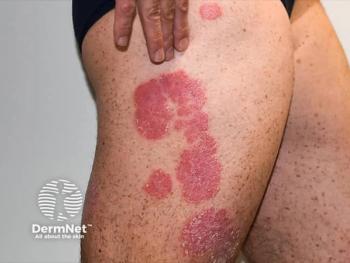
Transforming Risk Stratification in Melanoma and Squamous Cell Carcinoma
Key Takeaways
- Molecular testing enhances risk stratification and personalizes treatment plans for melanoma and SCC, surpassing traditional staging methods.
- Gene expression profiling classifies patients into risk categories, influencing follow-up strategies and treatment decisions.
Integrating molecular testing into melanoma and SCC management enhances risk assessment and personalizes treatment, revolutionizing patient care in dermatology.
A key takeaway from the recent Dermatology Times Case-Based Peer Perspective custom video series
Expanding Beyond Traditional Staging
Cotter highlighted the limitations of traditional staging systems, noting, “We really have to refine our treatment approaches. We have toutilize our gestalt based on standard-staging what we know about squamous cell carcinoma [SCC] biology but then do more.”
This reflects a growing recognition in dermatology that standard staging, though foundational, cannot always account for individual tumor behavior, which varies widely. He also emphasized the value of gene expression profiling.
“Once I know my patient’s gene expression profile risk level, it changes their follow-up strategy. But that depends also on some other factors, like what their initial T stage was,” Cotter said. For example, if a patient presents with a large, aggressive tumor, molecular testing can help determine whether additional treatments or closer follow-up are warranted, helping to customize management beyond what staging alone might suggest.
Gene Expression Profiling in Melanoma
In melanoma management, advances in molecular diagnostics are making a measurable impact. He described how gene expression profiling can classify patients into low-risk or high-risk categories with precision that complements traditional clinical and pathological assessments.
One validated example is a 31-gene expression profile test, which measures the relative expression levels of 31 different genes through neural network algorithms. “This test has been studied and published in over 50 peer-reviewed articles that include both retrospective and prospective studies [as well as] independent validation and development cohorts,” he added. Such extensive validation provides clinicians with confidence in its utility across diverse patient populations.
The test’s outcomes influence critical decisions, including whether to pursue more aggressive treatments or additional surgical interventions. “Once I know my patient’s gene expression profile risk level, it changes their follow-up strategy,” Cotter affirmed. This allows for tailored surveillance.
Molecular Testing and Managing SCC
Although melanoma has historically garnered more attention for molecular diagnostics, Cotter highlighted the growing importance of this approach in SCC. “There’s been so much success in the realm of molecular testing for melanoma that it was absolutely essential to develop a similar test for squamous cell carcinoma, and groups of dermatologists actually fought to get this test developed.”
The implementation of molecular tools in SCC is still emerging, but their potential to identify high-risk tumors that require additional intervention is rapidly becoming clear, Cotter said. Molecular diagnostics can fill treatment gaps by providing an objective, quantifiable measure of tumor aggressiveness.
The Future of Noninvasive Monitoring
Beyond tissue-based testing, Cotter discussed a new development: “Utilizing liquid biopsies to help manage our patients. They will eventually be relatively inexpensive and probably more sensitive than advanced imaging studies like PET/CTs and brain MRIs.” Blood-based molecular tests could provide clinicians with noninvasive, real-time information about tumor recurrence or progression, reducing the need for frequent imaging and invasive procedures.
He explained that he envisions a future where patients can walk into any laboratory and have their blood tested to assess whether tumors have returned, streamlining post treatment monitoring and improving quality of life. “Utilizing a molecular test to tell you if your tumors come back or not is absolutely fantastic and extremely exciting to have that for our patients,” Cotter said.
Ensuring Quality and Utility
Cotter emphasized the importance of selecting appropriate tests, advocating for those backed by solid evidence and validation. “When I think about what matters most to me, it’s validated research.... I want a test that I feel comfortable with that I can get to my patients with minimal cost and minimal effort.” The availability of tests that can be performed on existing tissue samples, such as formalin-fixed biopsies, makes integration into routine practice more feasible.
He advocated for a thoughtful approach, combining molecular data with conventional staging and clinical judgment rather than relying solely on one factor. “Every single time I’m in clinic,I’m managing risk for my patients. It doesn’t matter if it’s a squamous cell carcinoma patient or a melanoma patient or even a patient with atopic dermatitis, and we’re trying to pick [an] advanced systemic.... We’re seeing patients, and we’re making clinical decisions that impact their lives.”
Conclusion
The integration of gene expression profiling into the management of melanoma and SCC represents a shift toward more personalized and precise patient care. As Cotter emphasized, “We’re seeing patients, and we’re making clinical decisions that impact their lives. We’re managing risk. Understanding the patient’s individualized risk will influence our treatment patterns.” Molecular diagnostics, complemented by innovations such as liquid biopsies, hold the promise of detecting recurrences earlier, tailoring treatments more effectively, and ultimately improving patient outcomes.
Newsletter
Like what you’re reading? Subscribe to Dermatology Times for weekly updates on therapies, innovations, and real-world practice tips.


















